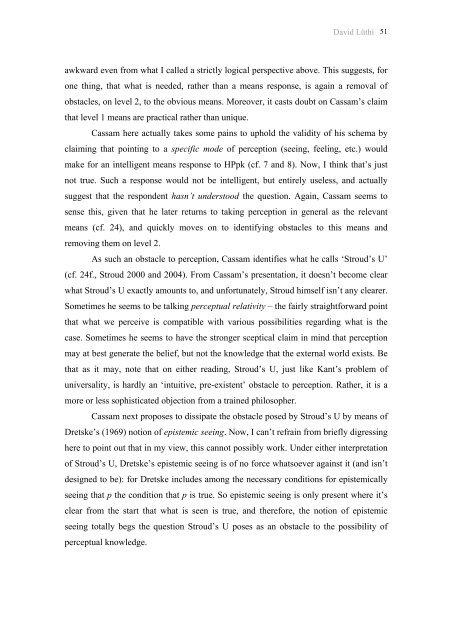Complete Issue in PDF - Abstracta
Complete Issue in PDF - Abstracta
Complete Issue in PDF - Abstracta
You also want an ePaper? Increase the reach of your titles
YUMPU automatically turns print PDFs into web optimized ePapers that Google loves.
David Lüthi 51<br />
awkward even from what I called a strictly logical perspective above. This suggests, for<br />
one th<strong>in</strong>g, that what is needed, rather than a means response, is aga<strong>in</strong> a removal of<br />
obstacles, on level 2, to the obvious means. Moreover, it casts doubt on Cassam’s claim<br />
that level 1 means are practical rather than unique.<br />
Cassam here actually takes some pa<strong>in</strong>s to uphold the validity of his schema by<br />
claim<strong>in</strong>g that po<strong>in</strong>t<strong>in</strong>g to a specific mode of perception (see<strong>in</strong>g, feel<strong>in</strong>g, etc.) would<br />
make for an <strong>in</strong>telligent means response to HPpk (cf. 7 and 8). Now, I th<strong>in</strong>k that’s just<br />
not true. Such a response would not be <strong>in</strong>telligent, but entirely useless, and actually<br />
suggest that the respondent hasn’t understood the question. Aga<strong>in</strong>, Cassam seems to<br />
sense this, given that he later returns to tak<strong>in</strong>g perception <strong>in</strong> general as the relevant<br />
means (cf. 24), and quickly moves on to identify<strong>in</strong>g obstacles to this means and<br />
remov<strong>in</strong>g them on level 2.<br />
As such an obstacle to perception, Cassam identifies what he calls ‘Stroud’s U’<br />
(cf. 24f., Stroud 2000 and 2004). From Cassam’s presentation, it doesn’t become clear<br />
what Stroud’s U exactly amounts to, and unfortunately, Stroud himself isn’t any clearer.<br />
Sometimes he seems to be talk<strong>in</strong>g perceptual relativity – the fairly straightforward po<strong>in</strong>t<br />
that what we perceive is compatible with various possibilities regard<strong>in</strong>g what is the<br />
case. Sometimes he seems to have the stronger sceptical claim <strong>in</strong> m<strong>in</strong>d that perception<br />
may at best generate the belief, but not the knowledge that the external world exists. Be<br />
that as it may, note that on either read<strong>in</strong>g, Stroud’s U, just like Kant’s problem of<br />
universality, is hardly an ‘<strong>in</strong>tuitive, pre-existent’ obstacle to perception. Rather, it is a<br />
more or less sophisticated objection from a tra<strong>in</strong>ed philosopher.<br />
Cassam next proposes to dissipate the obstacle posed by Stroud’s U by means of<br />
Dretske’s (1969) notion of epistemic see<strong>in</strong>g. Now, I can’t refra<strong>in</strong> from briefly digress<strong>in</strong>g<br />
here to po<strong>in</strong>t out that <strong>in</strong> my view, this cannot possibly work. Under either <strong>in</strong>terpretation<br />
of Stroud’s U, Dretske’s epistemic see<strong>in</strong>g is of no force whatsoever aga<strong>in</strong>st it (and isn’t<br />
designed to be): for Dretske <strong>in</strong>cludes among the necessary conditions for epistemically<br />
see<strong>in</strong>g that p the condition that p is true. So epistemic see<strong>in</strong>g is only present where it’s<br />
clear from the start that what is seen is true, and therefore, the notion of epistemic<br />
see<strong>in</strong>g totally begs the question Stroud’s U poses as an obstacle to the possibility of<br />
perceptual knowledge.




